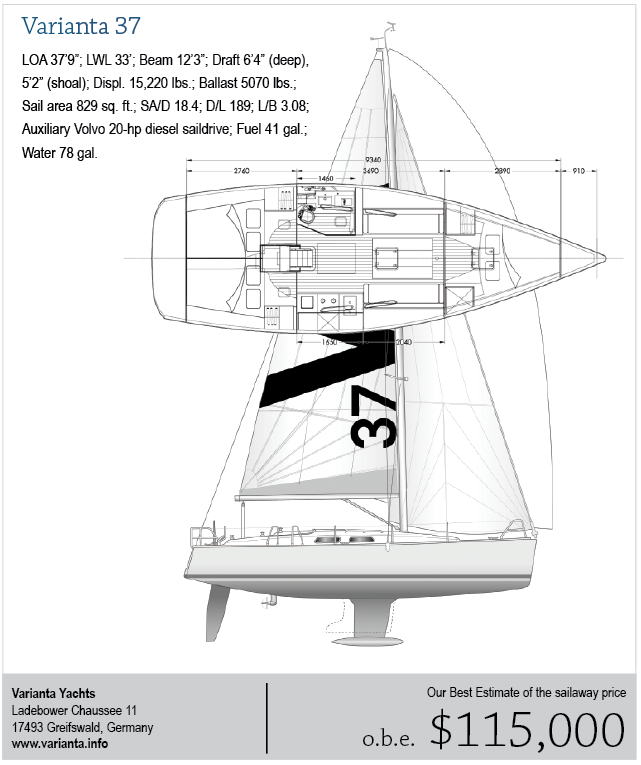Varianta 37
Performance cruiser
Judel/Vrolijk is the design name behind this new Varianta model, built as an entry boat for the Hanse line. It’s a clean-looking boat with modest styling, and it is a little more conventional looking than the typical current European models. But I like this simple look. It is clearly another contribution to the trend towards higher performance in a dual-purpose cruiser-racer.

The hull departs from the current trend: the chine is missing. I do not see that as a negative. It’s just another way of doing it. You can still have a firm or even hard turn to the bilge without resorting to a chine. The D/L is 189 and the L/B is 3.08, identical to the Elan 400.
The beam aft is not as proportionately wide as it is on the Marlow-Hunter or the Elan. For fun, compare the underwater profile of the Varianta to the Elan 400. Note how the low point of the hull rocker appears aft of the trailing edge of the keel on the Varianta, while it is at the leading edge of the keel on the Elan. That may not be important, depending on the distribution of volume. It could be done simply in an effort to get the engine mounted lower in the Varianta for accommodation reasons. Maybe not. I’m not going to second guess Judel/Vrolijk.
You can plot out the longitudinal curve of areas that shows the volume at each station of the hull. If you overlay the curve of areas for the Elan over that of the Varianta you could see if this hump in the profile translated to a shift in volume. Some designers have been known to design strictly to the curve of areas.
You can also compare longitudinal center of buoyancy locations. This center is generally around 54% to 56% of the DWL distance aft of the cutwater.
You can get either a 6 feet 4 inches draft keel or a shoal keel drawing 5 feet 2 inches. The deeper keel is a T-bulb. T-bulbs can catch a lot of kelp in Puget Sound. I’m sure they are great for caching lobster pots on the East Coast.
“Hold your course. Oh, look. Dinner!”
There is quite a bit more overhang aft on this model compared to the Elan. That will help maintain a cleaner wake with less transom drag.
The interior layout is simple and typical of most Euro models. Mirror image sleeping quarters aft, a small galley, adequate head, main saloon settee berths and a V-berth double. It will work well for three couples, but again, you give up cockpit locker space with that extra stateroom.
I would have liked to have seen the galley counter extend inboard about 26 inches to make this galley L-shaped. It would have opened up a lot of volume for a good-sized icebox. My change would have made the boat more expensive.
The rig has chainplates outboard on the hull and about 20 degrees of spreader sweep. The SA/D is on the low side for a fractional rig at 18.4. I’d prefer to see the SA/D around 22.00 for better light air performance. But there are some areas where the wind blows most of the time and this rig will be more than adequate.
The deck plan shows an open cockpit with notches in the seat fronts and top for the wheel to clear. Jib tracks are shown on one side of the cabintop only but that must be a drafting error. I don’t see any jib tracks on the deck. In fact, the drawing shows a line, presumably the jib sheet, leading to one of the winches flanking the companionway. Weird. There are primaries and secondary winches aft and I would think the jib sheet should lead to one of those. I don’t see a graceful way of getting the jib sheet from the top of the cabintrunk down to those winches aft. When I draw stuff like this my pal Tim says, “What were you planning on doing here Bob?”
My response is usually, “I was planning on calling you so you could fix it for me.” Tim has an encyclopedic memory of deck hardware and rigging methods.
I like the overall look of this boat and I am certain with the power of the Judel/Vrolijk office behind the effort the final result will be a very nice, entry-level yacht.

Comments